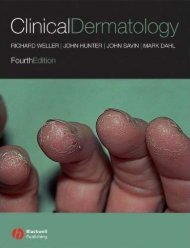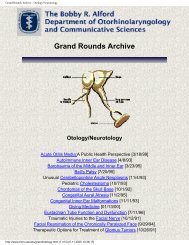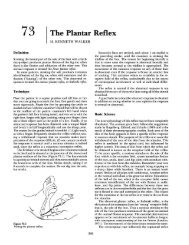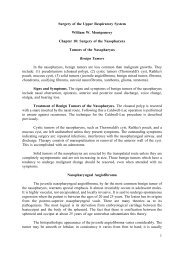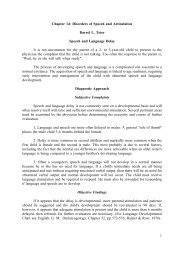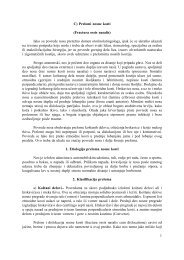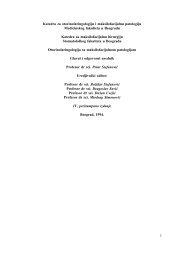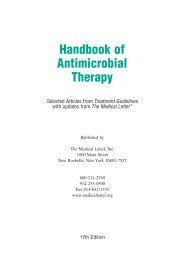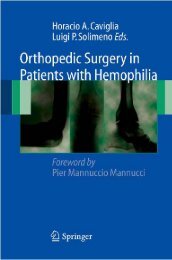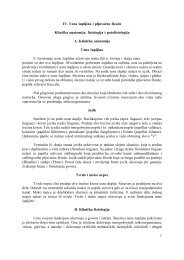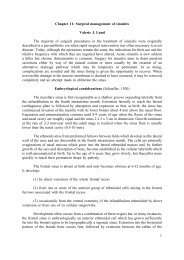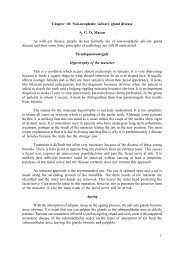1 Chapter 13: Acute suppurative otitis media and acute mastoiditis ...
1 Chapter 13: Acute suppurative otitis media and acute mastoiditis ...
1 Chapter 13: Acute suppurative otitis media and acute mastoiditis ...
You also want an ePaper? Increase the reach of your titles
YUMPU automatically turns print PDFs into web optimized ePapers that Google loves.
Nasopharyngeal tissue masses<br />
Adenoids<br />
Adenoids tend to block the eustachian tubes <strong>and</strong> also to act as a focus on infection<br />
from which organisms pass up the tube. However, controversy continues as to the exact role<br />
of the adenoids in <strong>acute</strong> <strong>suppurative</strong> <strong>otitis</strong> <strong>media</strong> as well as in non-<strong>suppurative</strong> middle ear<br />
effusions. Maw (1985) has shown that adenoidectomy is beneficial in resolving middle ear<br />
effusions, although the age of the child might be more significant, as children over 6 years<br />
showed better clearance than children under 6. It can be argued that the presence of adenoids,<br />
in impending eustachian tube function, would play a similar role in <strong>acute</strong> <strong>suppurative</strong> <strong>otitis</strong><br />
<strong>media</strong>. McKee, as long ago as 1963 in two careful studies showed evidence of the<br />
effectiveness of adenoidectomy in significantly reducing the incidence of <strong>acute</strong> <strong>suppurative</strong><br />
<strong>otitis</strong> <strong>media</strong>. Interestingly, he also showed that adenoidectomy alone was as effective in<br />
reducing <strong>acute</strong> <strong>suppurative</strong> <strong>otitis</strong> <strong>media</strong> as adenoidotonsillectomy, suggesting that tonsils rarely<br />
play any part in the aetiology. McKee also commented on the importance of age, the worst<br />
results having been achieved in children over 8, in whom the number of attacks would be<br />
declining anyway. However, it is well known that both children <strong>and</strong> adults with no adenoids<br />
can suffer frequent <strong>otitis</strong> <strong>media</strong> due to the many other factors involved. Careful assessment<br />
of the possible role of adenoids, as compared with other aetiological factors, in each<br />
individual case, is therefore m<strong>and</strong>atory.<br />
Other nasopharyngeal masses<br />
These act in a similar way to adenoids <strong>and</strong> include polyps, teratoma, angiofibroma,<br />
lymphoma <strong>and</strong>, in adults, carcinoma (see Volume 4, <strong>Chapter</strong> 19).<br />
Respiratory disease<br />
Chronic rhinitis <strong>and</strong> sinusitis produce a constant flow of infected mucus which may<br />
enter the eustachian tubes, while the infected sputum of bronchitis, bronchiectasis <strong>and</strong><br />
pneumonia may also be coughed into the nasopharynx <strong>and</strong> enter the tubes.<br />
Allergy<br />
The importance of allergy as an aetiological factor in <strong>acute</strong> <strong>suppurative</strong> <strong>otitis</strong> <strong>media</strong><br />
is still debatable. While allergic oedema of the eustachian tube undoubtedly occurs <strong>and</strong> might<br />
provide a rationale for recurrent <strong>acute</strong> <strong>suppurative</strong> <strong>otitis</strong> <strong>media</strong> in some cases, many atopic<br />
subjects have no ear problems.<br />
Pre-existing middle ear effusion<br />
A pre-existing middle ear effusion may act as a ready culture medium for invading<br />
pyococci.<br />
4




